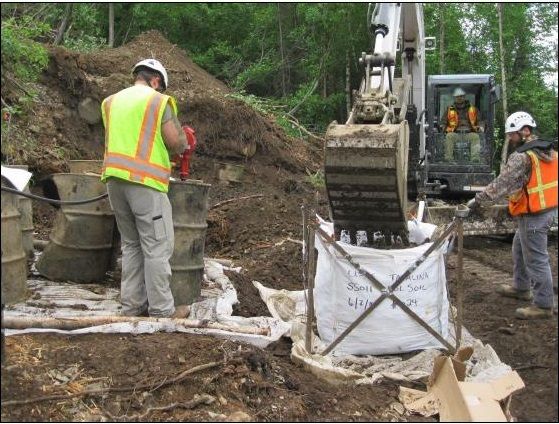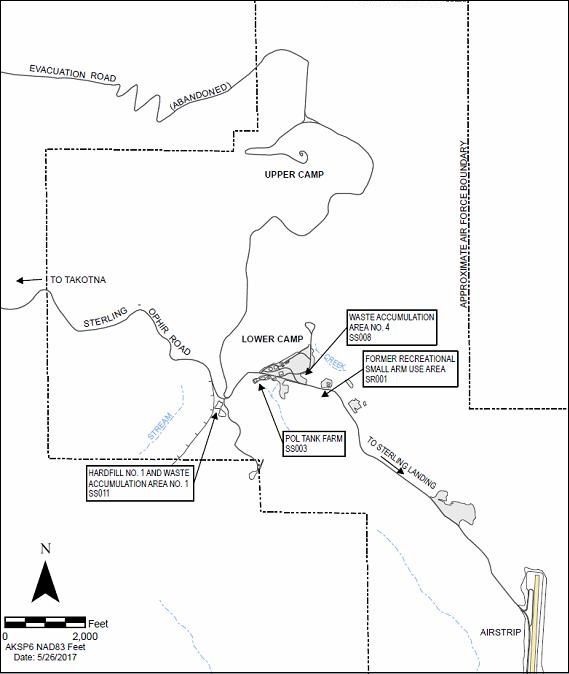Tatalina Long Range Radar Station (multiple sites at the facility)
- View detailed information from the database on this site.
- Database Name: Tatalina LRRS SS002 Spill/Leak 8 (Sterling Landing)
- Status: Active
- Location: McGrath
- Latitude: 62.884693
- Longitude: -155.942851
- U.S. Air Force Civil Engineer Center contact: Robert Johnston, Project Manager, 907-552-7193
- DEC Contaminated Sites contact: Axl LeVan, Project Manager, 907-451-2156
- Click on photos or maps for larger versions.
- Contacts updated: 10/10/2022
- Summary updated: 1/9/2023
Site Narrative
Description
Tatalina Long Range Radar Station (LRRS) is located 240 miles northwest of Anchorage on a 4,968-acre site, and is accessible only by air and water. The LRRS is divided into Upper and Lower Camps. The Upper Camp houses radar equipment and is located at the top of Tokotna Mountain. The Lower Camp has a runway and provides support to the Upper Camp from a composite facility constructed in 1984 which provides housing and industrial operations. Unlined landfills have received a variety of hazardous wastes, including lead acid batteries and waste solvents. Shop wastes, solvents and paint thinners, have been disposed of in an unlined trench.
Public Health and Environmental Concerns
Groundwater has been contaminated with petroleum and volatile organic compounds such as trichloroethylene (TCE), benzene, and tetrachloroethylene. Used oils, solvents, and fuel have been released onto the ground. The soil is contaminated with petroleum, polychlorinated biphenyl (PCB), Lead and chlorinated solvents.
People may be exposed to pollutants through contact with the skin or accidental ingestion of contaminated soil or water. Also, contaminants that may have built up in fish and other wildlife could pose a health threat to humans.
Taken from the Tatalina Long Range Radar Site (LRRS) 2017 USAF AFCEC JBER-AK Remedial Action-Construction Report for Sites SS003 (POL Tank Farm), SS008 (Waste Accumulation Area No.4), SS011 (Waste Accumulation Area No. 1 and Downslope of Hardfill No.1), and LF004 (Lower Landfill No. 2) and SR001 (Former Recreational Small Arms Use Area). All activities were conducted in 2016 in order to remove, transport, and dispose of polychlorinated biphenyl (PCB), petroleum hydrocarbon, and lead contaminated soil, as well as bioremediate petroleum hydrocarbon contaminated surface soil.

Excavation BH-21 is excavated and being sampled. View looking West June 26, 2016 (courtesy: Air Force Civil Engineering Center 2017)
Response Actions
- 1984: A cleanup of the White Alice site was undertaken, including demolition of all structures. Drums and other debris around the site were picked up and disposed in pits in the vicinity of the two dump areas. Both areas are located on the North side of the mountain, one at the White Alice site and one near the Upper Camp.
- 1998: The Air Force excavation and removal of buried drums and associated soil (approximately 15,000 cubic yards) contamination are from sites LF10 and SS011. The Air Force also conducted a successful removal of PCB contaminated soils from a former transformer storage area.
- 2000: The OT-006 no further action decision document is signed.
- 2001: A no further action record of decision is signed for DP-005, which includes Hardfill No. 2, the Northeast Landfill, and Morrison-Knudsen (MK) Debris Site. Institutional controls will include inspection of the cover material and documented to check for erosion of the cover material.
- 2011: The Air Force and ADEC signed a record of decision for SS002 (Sterling Landing). The selected remedy for soil and groundwater contamination is institutional controls (ICs) and long-term monitoring (LTM) for contaminated groundwater. After landfarming in 2007, 2009 and 3 rounds of treatment of the excavated soils in 2010, petroleum contamination remains above cleanup levels.
- 2013: The Air Force and ADEC signed a record of decision for SS003 (POL Tank Farm) SS008 (WAA No. 4) SS011 (WAA No. 1 and Downslope of Hardfill No. 1) and LF004 (Lower Landfill No. 2). Selected remedies: SS008: Off-site disposal PCB/TCE contaminated soil, LTM with ICs for groundwater at SS008, off-site disposal and ICs at SS011 and LTM with ICs for groundwater at LF004.

SS011 drum cache being excavated and drums are being prepped for removal. View looking South May 10, 2016(courtesy: Air Force Civil Engineering Center 2017)
- 2016: The Air Force and DEC signed a record of decision for SR001 (small arms use area) for lead contamination in soil. The selected remedy will remove lead contaminated soil from SR001, treat it with lead stabilizing chemicals that prevent leaching and disposal of the soils at LF004 Lower Landfill No. 2 on-site.
- The Air Force performed a removal action at SS008 and SS011 and removed a total of 58 cubic yards of soil. Remaining contamination at both sites was remaining at the site and further action was required at the site. This removal action also confirmed the landfarming cells at sites SS003 and SS008 had completed landfarming and no further tilling of soils was required. The work was reported on in 2017.
- 2020: DEC approved a Site Inspection Work Plan to investigate Per- and polyfluoroalkyl substances (PFAS) at six remote radar stations, including Tatalina LRRS. Work occurred in 2021 and the report is currently being updated based on new EPA screening levels for PFAS.
- 2021: The Air Force performed a follow up removal action at both SS008 and SS011. At SS008 approximately 500 tons of PCB-contaminated soil, but PCB contamination remained at the site. Remaining PCB contamination at SS008 was recommended for further investigation based on step out samples. At SS011, 61 55-gallon drums, 470-gallons of waste oil/petroleum liquids, and 71 tons of petroleum impacted soil and used liner material.
Current Status
In 2017, the first Five Year Review for LF004, SS002, SS003, SS008 and SS011 was conducted. Reviews of remedial actions are required by the Comprehensive Environmental Response, Compensation, and Liability Act (CERCLA) which result in any hazardous substances, pollutants, or contaminants remaining above levels that allow for unlimited use and unrestricted exposure. They are to be reviewed every five years to ensure protection of human health and the environment.
In 2018, the SS003 POL Tank Farm Spill site was assigned a cleanup complete determination with institutional controls for soil and groundwater by ADEC. Institutional controls will restrict access to the petroleum contaminated soils and groundwater until cleanup levels are met. Periodic reviews of the site conditions, long-term monitoring results and institutional controls will be conducted to ensure the cleanup remedy remains protective of human health and the environment.
No issues were identified that would affect the current protectiveness of the remedies at the sites which were selected for implementation in a 2013 record of decision. There are some notices of environmental contamination which need to be filed with AK Dept. Of Natural Resources Land Records to ensure long-term protectiveness at these sites. The next review will be due no later than 2023.


